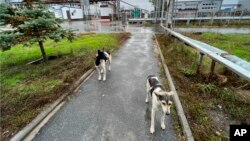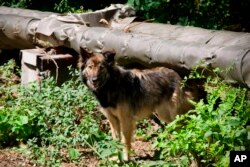More than 35 years after the world's worst nuclear accident, the dogs of Chernobyl, Ukraine, live among empty buildings in and around the closed nuclear center. The animals continue to find food, mate and survive.
Scientists hope that studying the dogs can teach humans about new ways to live in severely difficult, unforgiving environments.
The researchers published a genetics study recently in the magazine Science Advances. It centers on 302 dogs living in a government identified “exclusion zone” around the area of the disaster. The area has dangerously high levels of radiation.
The scientists identified dog populations that received different levels of radiation. The research found genetic differences among the dog groups that make them different from one another and other dogs in other parts of the world.
Genetics expert Elaine Ostrander with the National Human Genome Research Institute is one of the study investigators. She said the scientists had a great chance to examine a situation that could help answer an important question: “How do you survive in a hostile environment like this for 15 generations?”
Tim Mousseau is a professor of biological sciences at the University of South Carolina and a member of the study team. He said the dogs “provide an incredible tool to look at the impacts of this kind of a setting” on mammals.
Chernobyl’s environment is fierce. On April 26, 1986, an explosion and fire at the Ukraine power plant released huge amounts of radioactivity into the atmosphere. Thirty workers were killed immediately. Later deaths from radiation poisoning are estimated to be in the thousands.
Researchers said most of the dogs they are studying appear to have ancestral ties to family dogs left behind when their owners fled the danger.
Mousseau has been working in the Chernobyl area since the late 1990s. He began collecting blood from the dogs around 2017. Some of the dogs live in the power plant. Others are about 15 kilometers or 45 kilometers away.
At first, Ostrander said, the team thought the dogs might have mated so closely over time that they would be much the same. But the testing of their genes showed that the dogs lived in areas of different radiation levels – low, middle and high.
It was a major finding. Ostrander said the scientists could identify families” of about 15 different dog groups.
Now researchers can begin to look for changes in genetic structures among the groups.
“We can compare them and we can say: OK, what’s different, what’s changed, what’s mutated, what’s evolved, what helps you, what hurts you at the DNA level?” Ostrander said.
Scientists said the research could have wide uses. It could show how animals and humans can live now and in the future in areas under “continuous environmental” attack and in the high-radiation environment of space.
Kari Ekenstedt is an animal doctor and professor at Purdue University in Indiana who was not involved in the study. She said the study is a first step toward answering important questions about how higher level radiation affects large mammals. For example, she said, “Is it going to be changing their genomes at a rapid rate?”
Scientists have already started on additional research. It will require more time with the dogs in the area about 100 kilometers from Kyiv. Mousseau said he and his teammates were there most recently last October and did not see any war activity. Mousseau said the team has grown close to some dogs
“Even though they’re wild, they still very much enjoy human interaction," he said, “Especially when there’s food involved.”
I’m Caty Weaver.
Laura Ungar reported this story for The Associated Press. Caty Weaver adpated the story for Learning English.
____________________________________________________________________
Words in This Story
exclusion zone –n. an area that people are prevented from entering for safety or other reasons
incredible –adj. difficult to believe; extremely good
impact –n. the results of an event or condition
mammal –n. a kind of animal that has hair, certain ear bones and feeds milk to its young
mutated –adj. changes into another form
rapid –adj. fast; happening or moving quickly
____________________________________________________________________
We want to hear from you.
We have a new comment system. Here is how it works:
- Write your comment in the box.
- Under the box, you can see four images for social media accounts. They are for Disqus, Facebook, Twitter and Google.
- Click on one image and a box appears. Enter the login for your social media account. Or you may create one on the Disqus system. It is the blue circle with “D” on it. It is free.
Each time you return to comment on the Learning English site, you can use your account and see your comments and replies to them. Our comment policy is here.










Forum